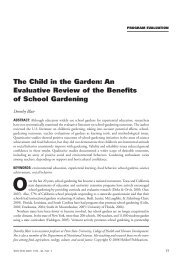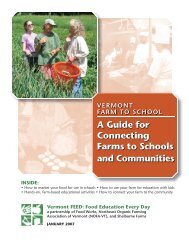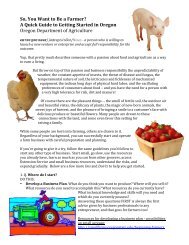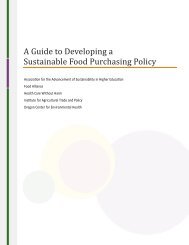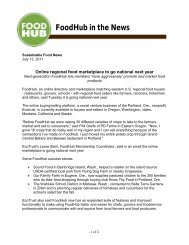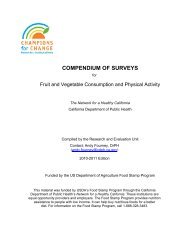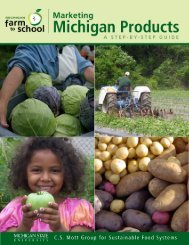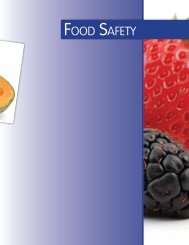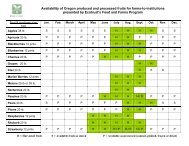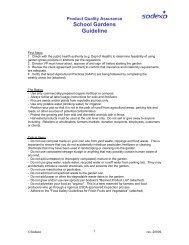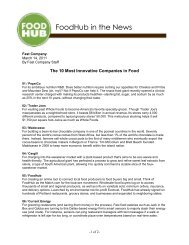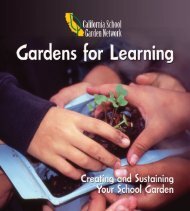eval report cover.indd - New Jersey Farm to School Network Wiki
eval report cover.indd - New Jersey Farm to School Network Wiki
eval report cover.indd - New Jersey Farm to School Network Wiki
Create successful ePaper yourself
Turn your PDF publications into a flip-book with our unique Google optimized e-Paper software.
ESY-CA: THE EDIBLE SCHOOLYARD AT MARTIN LUTHERKING JR. MIDDLE SCHOOL, BERKELEY, CALIFORNIAConclusions <strong>Farm</strong> <strong>to</strong> <strong>School</strong> and RecommendationsProgram ProfilesThe mission of The Edible <strong>School</strong>yard is <strong>to</strong> createand sustain an organic garden and landscape thatis fully integrated in<strong>to</strong> the school’s curriculum andlunch program. It involves the students in all aspects offarming the garden along with preparing, serving and eatingthe food.An <strong>eval</strong>uation of the first two years of the ESY-CA programwas conducted by the Center for Ecoliteracy andpublished in 2003. The study focused on the experiencesand learning patterns of participating students at MartinLuther King Jr. Middle <strong>School</strong>. Participants spent timein ESY’s garden and kitchen classroom, compared withother students from another Berkeley middle school withno garden or kitchen classroom on its school grounds atthe time of this research. This initial study focused on theholistic pattern of education for sustainability, including:ecological knowledge and understanding; environmentalattitudes and behaviors; cooperative school culture (e.g.improvement in self-esteem, interpersonal relationships,Martin Luther KingJr. Middle <strong>School</strong>Berkeley, CAFree / reduced mealeligibility: 38.4%Total schools: 1Enrollment: 886Demographics:33.6% White, 25.2% African-American, 19% HispanicLocal product used in:Garden produce usedin kitchen classroomOther programcomponents:Organic Garden, KitchenClassroom, ecological andenvironmental educationand attitude <strong>to</strong>ward school); and sense of place. In addition, the study included children’shealth by looking at their attitudes, beliefs, and knowledge regarding fruits and vegetables.Information sources included both qualitative and quantitative data. Data were derived fromsurveys and interviews with students, school leaders, teachers, and parents. The researchteam consisted of several researchers who looked at school records <strong>to</strong> assess grades, testscores, and attendance. One hundred five sixth graders, half from the Martin Luther KingJr. Middle <strong>School</strong> and half from the control school, were surveyed for this study. Pre-andpost-assessments <strong>to</strong>ok place at the beginning and end of the school year, respectively.Sixty-four teachers from the two schools fi lled out surveys about educational climate and26 ESY teachers contributed information about the subjects and students they taught. Theassessment <strong>to</strong>ols looked for students <strong>to</strong>: identify fruits, vegetables, and parts of plants; ordereleven garden-cycle scenes; demonstrate their understanding of ecological concepts; reflectupon their sense of place by ascertaining if the students knew the name of the closest bayas well as where the water for this bay originates; and probe each student’s relationship <strong>to</strong>the environment.Education for Sustainability. Findings from the Evaluation Study of the Edible <strong>School</strong>yard, April 2003.70 Bearing Fruit: <strong>Farm</strong> <strong>to</strong> <strong>School</strong> Evaluation Resources and Recommendations



